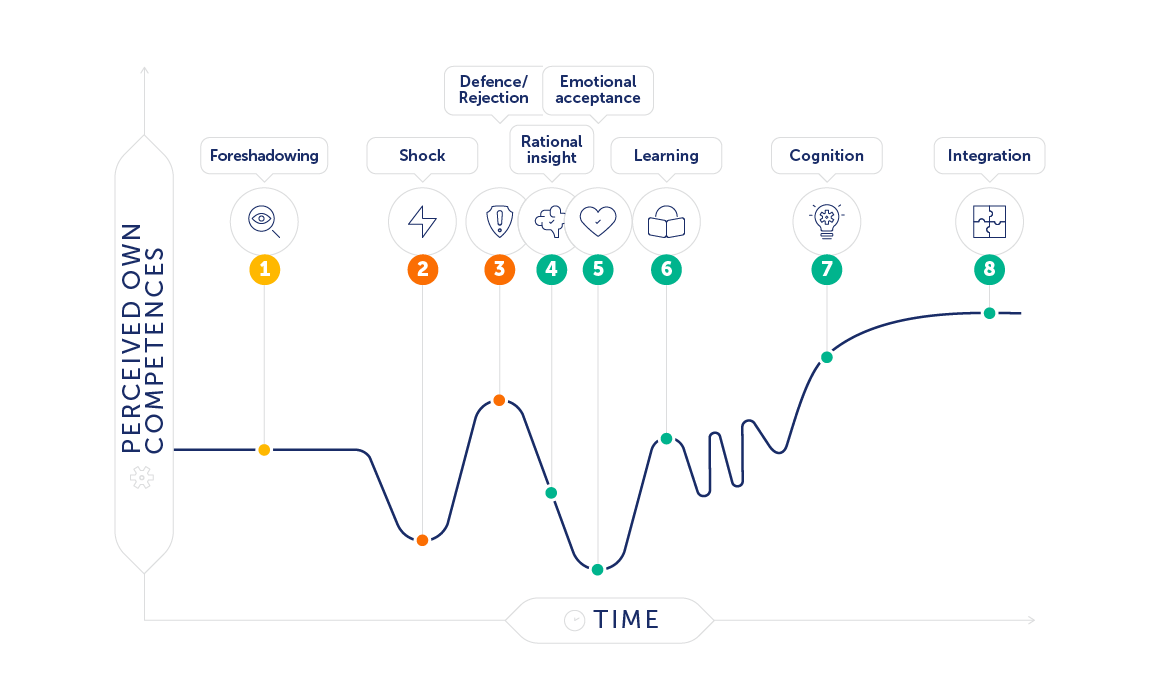Agile change management – it doesn’t have to be one big throw of the dice
Show me similar content
Change Management
As Mark Twain is once said to have remarked: “Prediction is difficult – particularly when it involves the future.” All the same, change is more than likely only going to get bigger and faster in the future. That makes change expertise perhaps the most important must-have for organizations navigating the digital world of the 21st century, which is already being shaped by disruptive upheaval and considerable planning uncertainty.
Agile change management is required
For organizations to overcome these challenges, they need change concepts that are simple, efficient and – most importantly – new. After all, with a success rate of around 30 percent, traditional change management has long been seen by some as ill-equipped to meet the change needs brought about by digitalization. What’s more, there is little to suggest that things will play out any different as long as project teams stick to conventional approaches. For many organizations, it is therefore high time to completely rethink how they handle change and adopt an agile strategy so they can become a learning organization that embraces agile principles and agile methodology.
The reason why traditional change management fails.
To understand the urgency of the situation, you need only look at the main reasons that traditional change management approaches have such a modest success rate. In the vast majority of cases, they fail due to a lack of flexibility and because of resistance from stakeholders, since both are low priorities in classic top-down approaches. At the top of the agenda for the project management team is organizational readjustment, along with the associated targets and necessary change measures based on best practices. Everything usually revolves around a grand and complex project that is planned in minute detail by the management team and rolled out in line with set milestones and directives from on high.
Although change initiatives based on the classic waterfall method have the advantage of giving project managers a high level of planning certainty, they can hardly be described as agile. Each phase is systematically executed according to a plan. Iterative interim stages or even retrospective corrections are certainly not part of that plan – not even if the initial scenario or customer requirements change in the meantime.
The risk of pushing through a change project even when it has been rendered obsolete halfway through is not the only danger. Ultimately, change needs to be actually implemented and it is not uncommon for executives to more or less overlook the people who actually have to take those practical steps. These stakeholders are either only brought on board once all the plans have been laid, or aren’t given enough information, or they are presented with done deals so that the planned change comes as a complete surprise. Some will welcome the change, but others will respond with incomprehension, feel overwhelmed and completely reject the planned measures. Focused change communication is very different!
Problems are almost impossible to fix
The problems associated with this lack of buy-in are almost impossible to resolve through communication, although many organizations will employ the full spectrum of communication media, from video events and townhall meetings to face-to-face individual discussions. The error lies in the system – the DNA of classic change management processes, if you will. For example, it is crucial to clarify the what, the why and the how for every single project and share that information with stakeholders. Success or failure will be decided by how these questions are answered, when they are answered and who communicates the information – regardless of the method or issue. However, this task of anchoring change projects in the organization’s culture and creating an agile mindset proves to be a stumbling block for so many organizations, as has been shown time and again in change management surveys.

If expertise is continuously built up during change processes, what starts out as rejection can be transformed into curiosity and then into a genuine desire to integrate new applications or processes into day-to-day work.
How agile change management differs
Agile or lean change management avoids these kinds of risks and problems because, unlike when following a traditional approach, agile organizations don’t have any comprehensive preliminary planning or big bang. Change is more of a continuous theme for agile change managers – a process that is centered around small, iterative steps and involves the people who are affected. In specific terms, that means staff shape the changes themselves and put them into practice step by step at a pace that suits them.
The basic idea behind agile change management
The idea for this radical new approach to change management can be traced back to the “Agile Manifesto” that a group of software developers devised in 2001 after a networking event in Utah. They were frustrated at how long it was taking to get from a customer expressing their desire for something to actually providing the finished product. Their solution was to formulate a set of basic values that have become the cornerstones of agile work:
- Changes are always welcome, even at late stages in a project.
- Changes are not rolled out on a grand scale, but rather in small sprints that last just a few weeks.
- Instead of stipulating detailed solution roadmaps, individual steps toward the objective are developed independently and given the necessary support.
- The status quo and potential for improvement are discussed at regular intervals. Agile teams adapt their activities according to the outcomes of these discussions.
Key success factor for agile change
One key success factor when it comes to transformation in an agile environment is a high level of acceptance among the stakeholders involved. There is a method to this, too. As in the case of agile product development, the intended effects of change management are not exclusively set from the top down, but are instead validated by the change team through regular feedback loops. If this monitoring process shows that progress is falling behind expectations and acceptance is not quite there, the plan is adjusted and re-validated until the outcome is right and the next change project can be tackled.
Continuous improvement based on experimenting, learning and adapting
When it comes to achieving the relevant project objectives safely and securely, the agile change cycle offers change managers and executives a practical user guide so they can test things out in smaller subprojects.
Building hypotheses and experimenting
The cycle kicks off with the creation of hypotheses based on information, findings and the options available. This offers a means of identifying the processes that are not running smoothly, the change measures that could help and the potential pitfalls. Which options win through will depend on several variables, such as cost, achievable quick wins and the possible subsequent risks. Once the team has made a decision, it’s time to start experimenting, ideally on the basis of design thinking. That means speed is more important than precision.
Learning from rapid feedback
Agile change management is adaptive project management for putting change into practice and thrives on rapid feedback. Hearing directly from everybody affected by the new scenario ensures that changes are adapted methodically and precisely to actual requirements or new circumstances. Sharing additional information, comments and responses to comments on a daily basis gives the team the opportunity to react rapidly and with flexibility – without being hampered by predetermined plans.
Continuous improvement
Agility in change management helps make all parties better able to cope with change, because it promotes a culture of continuous improvement. Unlike under traditional change management, this kind of change is not a one-off event that is done and dusted after a “big bang”. Instead, agile transformation is more of a continuous, feedback-driven process that contributes to the enhancement and ongoing development of the entire organization by taking little steps in lots of different areas. This helps avoid bigger risks and establishes a productive error culture that creates new space for innovation to thrive. Continuous training and coaching courses led by change agents or an agile coach or scrum master accompany this process.
Just as in the case of traditional change projects, communication is also a key success factor when change management is handled in agile projects. In this case, however, feedback comes first, because it has a decisive role in making a change successful and therefore needs to be systematically nurtured. That includes highlighting instances where staff feedback has led directly to improvements, as this helps maximize motivation to actively engage with the continuous improvement process.
Lean management – where agile change meets a start-up mindset
“Agile change management” itself is also evolving and is increasingly regarded as synonymous with “lean change management”. To be fair, there are barely any differences between the two in terms of methodologies. However, although few in number, differences do exist. For example, the lean version of change management is based on the 2011 book “The Lean Startup” by Eric Ries, which sets out solutions for the most economical, risk-free and yet efficient product development in startups.
Lean change management uses the short and usually non-hierarchical routes typical of startups so that, when completely unforeseeable (and therefore unplannable) situations arise, a starting point can be found for kicking off improvements. There are no hard and fast rules for how to approach this. For instance, tools, methods and models from agile and conventional change management, systems theory and neurosciences can all be utilized in all project stages. That means organizations wanting to evolve in an agile way or set themselves up on a comprehensively digital footing can pick and choose the best from all the various worlds of change to suit their needs.
Conclusion – it doesn’t have to be one big throw of the dice
Agile change management has earned its place in management theory because it helps organizations cope with the rapid pace at which their circumstances are changing. Digitalization offers a prime example of that. Unlike traditional, disruptive change management, an agile approach is more of a constant throughout a digital transformation. It does not attempt to implement changes with one big throw of the dice, but rather coaxes a step-by-step digital evolution that can be adapted dynamically to new situations as they emerge.
It is down to each individual organization to determine what exactly its procedure for change management looks like and whether it should focus on agile change or lean change. What really matters across the board is making a start and building up experience together. It’s also really important not to be anxious! Even bad experiences are valuable, because they show how things can be done better. When will you dare take the first step into the agile world?
Show me similar content
Change Management



